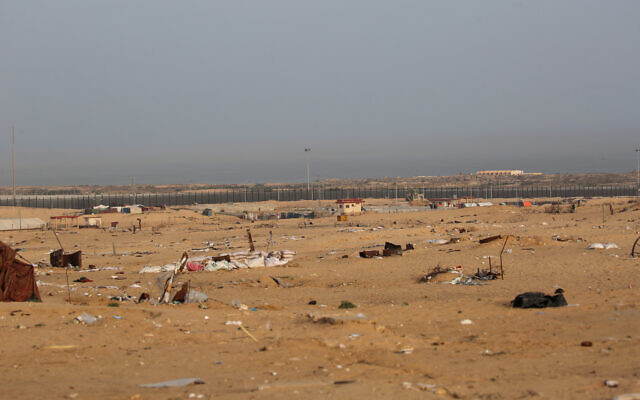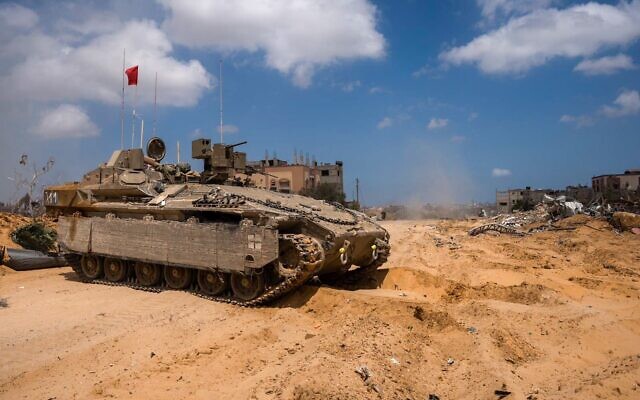



Israeli tanks advanced to the edge of a district in the heart of Rafah on Wednesday during what residents said was one of the most intense nights of bombardment of the city in the southern Gaza Strip since Israel launched its offensive there earlier this month.
The Israel Defense Forces’ assault on Hamas in Rafah has set some 950,000 people fleeing what had been a refuge for around half of Gaza’s 2.3 million people.
Some 300,000 to 400,000 civilians remain in Rafah, mostly in the coastal area and some parts of the center of the city, according to information seen by The Times of Israel on Monday.
The IDF has asserted that Rafah is Hamas’s last major stronghold in Gaza, and where four of its battalions are located: Yabna (South), Shaboura (North), Tel Sultan (West) and East Rafah. Two more Hamas battalions remain in central Gaza, in the Nuseirat and Deir al-Balah camps.
Israel believes Hamas leaders and many operatives are hiding in Rafah, and also that an unspecified number of the remaining 124 hostages kidnapped in the Hamas-led October 7 atrocities are being held in the city. Israel says it has no choice but to attack the city to root out the Hamas battalions there.
The military has been slowly moving into the eastern outskirts of Rafah since the start of the month, as Palestinians have evacuated to the al-Mawasi area, designated by the IDF as a “humanitarian zone,” on the Strip’s coast, and to central Gaza.
Residents quoted by Reuters said tanks had taken up new positions on Wednesday further west than before along the southern border fence with Egypt, and were now stationed on the edge of the Yabna neighborhood in the center of Rafah.
“There has been no stopping of Israeli fire all night, from drones, helicopters, warplanes, and tanks,” one resident of Rafah told Reuters.
The IDF said Wednesday that troops of the 401st Armored Brigade located several rocket launchers on the so-called Philadelphi Corridor, the border area between Gaza and Egypt.
The primed launchers were destroyed, the military said.
So far amid the operation in southern Gaza’s Rafah, the IDF has captured just over half of the Philadelphi Corridor — which runs for a total of 14 kilometers (8.7 miles) all along the Gaza-Egypt border — according to information seen by The Times of Israel on Monday.
The military has said that it has located dozens of tunnel shafts and “a number of significant underground routes” in the eastern Rafah area that are currently under investigation or being prepared to be demolished.
It has not, however, detailed how many of the tunnels cross into Egypt. In the past, Hamas used such tunnels to smuggle in weapons and supplies.
The United States and other allies had pressed Israel for months not to invade the city, citing the likely humanitarian consequences. Though on Tuesday, a senior Biden administration official told reporters that “it’s fair to say that the Israelis have updated their plans. They’ve incorporated many of the concerns that we have expressed.”
The US had predicted that it would have taken some four months to evacuate the population of more than one million sheltering in Rafah, while the majority appear to have left the area in just two weeks.
Meanwhile, the IDF said Wednesday that it carried out an airstrike against a United Nations school in central Gaza’s Nuseirat where members of Hamas were gathered.
According to the Israel Defense Forces, a member of Hamas’s anti-tank unit and a member of the terror group’s elite Nukhba force were at the school, which is administered by the UN Relief and Works Agency (UNRWA).
The UNRWA site had been used to store weapons, including mortars, guns and explosive devices, the army said, citing secondary blasts seen after the strike, which the military said indicated weapons storage.
The strike was “carefully planned and carried out using precise munitions” while “avoiding harm to uninvolved [civilians] as much as possible,” the IDF said.
Israel has previously accused UNRWA of enabling Hamas to use its facilities in Gaza for terror. It has also provided evidence that several agency employees are members of terror groups and were involved in the October 7 attack.
The UN rejects the allegations, and an independent review published at the UN’s request in April said that Israel had not provided supporting evidence for them.
A separate airstrike killed five Hamas operatives who were also gathered at a school in the area of Gaza City’s Daraj and Tuffah neighborhoods, the military said.
The IDF said that those killed in that strike were Fadi Salim, the head of the propaganda unit in Hamas’s Gaza City Brigade, three members of Hamas’s intelligence unit, and another Nukhba member.
Another airstrike, in the southern Gaza Strip, killed Ahmed Yasser al-Qara, a “prominent” member of Hamas’s anti-tank unit who participated in the October 7 onslaught, the IDF said. Also killed in that strike were a Nukhba member and an operative of Palestinian Islamic Jihad, according to the military.
The IDF said it delayed the strike targeting al-Qara after a child was identified in the vicinity of the building. It waited until the child was a safe distance away before launching the attack.
Meanwhile, in the northern Gaza Strip, the IDF was pressing on with a major operation against Hamas in the Jabaliya area.
The fighting in Jabaliya has been described by the IDF as “intense,” and by some officers as the “most violent” battles amid the war.
On Wednesday, the IDF said primed rocket launchers were found by troops of the 7th Armored Brigade amid operations in Jabaliya, as were dozens of rockets along with explosive belts, IEDs, grenades and other weapons.
Troops have raided and demolished dozens of sites belonging to terror groups amid the operation that began earlier this month, the military said.
On May 12, the IDF pushed into Jabaliya for the third time, in a surprise operation aimed at dismantling Hamas cells that had regrouped there after the military withdrew months ago.
According to the IDF, more than 200 terror operatives have been killed by troops amid the fighting in Jabaliya, and dozens of rocket launchers have been destroyed.
Speaking to officers in Jabaliya on Tuesday, IDF Chief of Staff Lt. Gen. Herzi Halevi said the military was willing to carry out risky missions to recover the bodies of slain hostages.
“The mission… is to kill as many [Hamas] commanders as possible, as many terrorists as possible, to destroy the infrastructure. This pressure… will also help us to bring hostages alive and we are ready to carry out dangerous and complicated operations to bring the bodies of our hostages back to be buried in Israel,” Halevi said.
The bodies of four hostages killed by Hamas terrorists on October 7 were recently recovered from a tunnel in Jabaliya. A paratrooper officer was killed during fighting above ground in the area of the operation.
The war in Gaza erupted after Hamas’s October 7 massacre, which saw some 3,000 terrorists kill close to 1,200 people in southern Israel and seize 252 hostages.
The Hamas-run Gaza health ministry says more than 35,000 people in the Strip have been killed or are presumed dead in the fighting so far, though only some 24,000 fatalities have been identified at hospitals. The tolls, which cannot be verified, include some 15,000 terror operatives Israel says it has killed in battle.
Two hundred and eighty-three soldiers have been killed during the ground offensive against Hamas and amid operations along the Gaza border. A civilian Defense Ministry contractor has also been killed in the Strip.




